
Here is a listing of standard package types found on many arcade PCBs. The bulk
of these are shown purely for reference.
Many of these are surface mounted and require expensive adapters to be able to
read them. The 'Categories' listed in
BLUE are types used for storage of information on arcade PCBs. The
'Pin Count' listed in RED are the ones I have the
capability to read using my equipment and various adapters etc.
| Categories |
Typical Sample
(not to scale) |
Pin Counts |
Lead Pitches [mm] |
Remarks |
DIP
(Dual-in-line Package) |
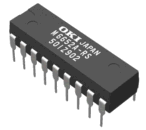 |
8, 16, 14,18, 20, 22, 24, 28, 32, 36, 40, 42, 48 |
2.54 |
100mil pitch type.
8 and 28 used for EEPROM.
14, 16, 18 used for PROMs.
20, 22, 24 used for PAL/GAL
28 to 42 used for UV EPROM and OTP (Mask) ROM and MCUs (generally 32 and 40). |
SDIP
(Skinny Dual-in-line Package) |
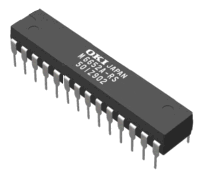 |
20, 22, 28 |
2.54 |
100mil pitch type, but not as wide plastic package vs number of legs. For example MB8464 Static RAM which has 28 legs
but is only 200mil wide vs the older type 6264 RAMs that are 600mil wide. Most common to see these skinny DIP chips for static
RAMs. 22 used for older 2101 / 5101 static RAMs used on Galaxian and Bally/Stern pinball CPU boards but these are 400mil wide. |
SDIP
(Shrink Dual-in-line Package) |
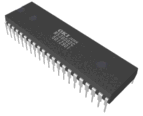 |
30, 42, 64 |
1.778 |
70mil pitch type, commonly used for Toshiba/Hitachi/Motorola MCU and
68000/Z180 CPU. These were also used as graphic or custom chips in the late 80's and right
across the 90's on arcade PCBs before the use of surface-mounted QFP's became popular. |
ZIP
(Zig-Zag In-line Package) |
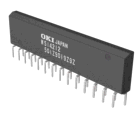 |
20, 24, 28, 40 |
1.27 |
50mil pitch type, commonly used for RAM |
SOP
(Small Outline Package) |
 |
8, 14, 16, 20 |
1.27 |
Also known as SOIC (Small Outline Integrated Circuit). Some
common uses are logic IC's, op amps, voltage regulators and EEPROMs. Typically these chips come in package widths 150mil (3.81mm), 200mil (5.08mm) and 300mil (7.62mm). This size is the plastic package width not across the legs. |
SOP
(Small Outline Package) |
 |
24, 28, 32, 40, 44 |
1.27 |
24 used for EEPROM (i.e. AT28C16)
32 to 44 used for OTP (mask) ROM and Flash ROM with 4MBit to 64MBit storage
capacities. Typically these are larger chips with width starting at 300mil (7.62mm) or 400mil (10.16mm) |
SSOP
(Shrink Small Outline Package) |
 |
20, 28, 30, 32, 56, 60, 64, 70 |
0.65, 0.80, 0.95, 1.00 |
56 with 0.80mil pitch used for Flash ROM with 16MBit to 64MBit storage capacities. 70 used in large capacity 256Mbit,
512Mbit and 1Gbit mask ROMs. Also used on more recent logic chips with 0.635mm pin spacing in 200mil and 150mil wide packages and 14, 16 and 20 pins for PCB
space saving.... basically same number of pins as SOIC but half the chip length and half the pin spacing size. |
TSOP(1)
(Thin Small Outline Package) |
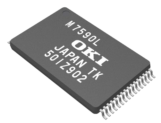 |
32, 40, 48, 56 |
0.50 |
Type I, leads on short side. Used for OTP (mask) ROM and
Flash ROM with 1MBit to 128MBit storage capacities. These are the most
common type of surface mounted ROMs used on arcade PCB's. |
TSOP(2)
(Thin Small Outline Package) |
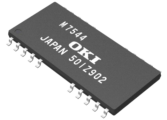 |
26(20), 26(24), 28, 28(24), 32, 44, 44(40), 48, 50, 50(44), 54,
56, 66, 70(64), 86 |
0.50, 0.65, 0.80, 1.27 |
Type II, leads on long side. Many of these pin counts are
not commonly used on arcade PCB's..
48 with 0.80mm pitch used for OTP (mask) ROM with 16MBit to 128MBit storage
capacities. 44(40) used in GNET carts and are type TC58V32 and TC58V64
(32MBit and 64MBit 3.3V NAND Flash Serial EEPROM) |
QFP
(Quad Flat Package) |
 |
44, 56, 64, 80, 100, 128, 160, 208, 240, 272, 304 |
0.50, 0.65, 0.80, 1.00 |
Used for many
applications on arcade PCBs, mostly graphics chips and custom chips.
QFP80 used for Hitachi HD647180 MCU. QFP64 and QFP100 used for some CPU's
also. |
LQFP
(Low Profile Quad Flat Package) |
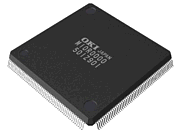 |
144, 176, 208 |
0.50 |
1.4mm body thickness.
Same as QFP only thinner. QFP64 and QFP100 used for CPLD programmable logic chips. QFP144 used for Hitachi SH1 and SH2 CPUs. Many other graphics and custom chips use QFP100, QFP120, QFP160, QFP208 |
TQFP
(Thin Quad Flat Package) |
 |
44, 48, 64, 80, 100, 120 |
0.50, 0.80 |
1.20mm body thickness
Same usage as QFP and LQFP only thinner. Used in many applications such as graphics processors and other programmable
chips such as CPLDs (Xilinx/Amtel/AMD etc) |
SOJ
(Small Outline J-lead) |
 |
26(20), 26(24), 28, 28(24), 32, 36, 40, 42, 50 |
0.80, 1.27 |
Two J-lead lead rows
Commonly used for RAM. These chips can be
either directly surface mounted, or held in a socket.
|
QFJ / PLCC
(Quad Flat J-lead /
Plastic Lead Chip Carrier) |
 |
20, 28, 32, 44, 68, 84 |
1.27 |
Used for many applications on arcade PCBs. Some examples
are 68000, 34010, 320C25 CPUs (plus several other CPUs), PLDs/CPLDs, PAL/GAL etc.
EEPROMs/OTP EPROMs or flash ROMs from 8kB (i.e. 28C64) to 8M are also occasionally seen but the most common
use of PLCC EPROMs/EEPROMs/flash ROMs is on PC motherboards to hold the BIOS.
These chips can be either directly surface mounted, or held in a socket. |
BGA
(Ball Grid Array) |
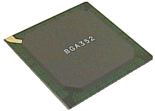 |
256, 352, 420, 560 |
1.00, 1.27 |
Epoxy package, SnPb balls. Commonly used for graphics
processors on PC video cards and also used on some very late model arcade
boards such as the ones that are Playstation 2-based and PPC-based. Also used on many late model Sega PCBs, such as Model 3 Step 2.1, NAOMI and Hikaru |
FBGA
(Fine Ball Grid Array) |
 |
48, 84, 104, 144, 176, 224 |
0.80 |
Epoxy package, SnPb balls. Similar uses as BGA's listed
above. |
FLGA
(Fine Land Grid Array) |
 |
49, 56, 84 |
0.80 |
Epoxy package, Au-plated lands |
W-CSP
(Wafer-level Chip Size Package) |
 |
47, 48, 111, 141, 160 |
0.40, 0.50, 0.80 |
Packaged wafer cut into chips |
TCP
(Tape Carrier Package) |
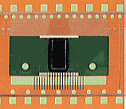 |
various, up to 544 |
various ILB and OLB |
Width types 35, 48, 70mm |
|



